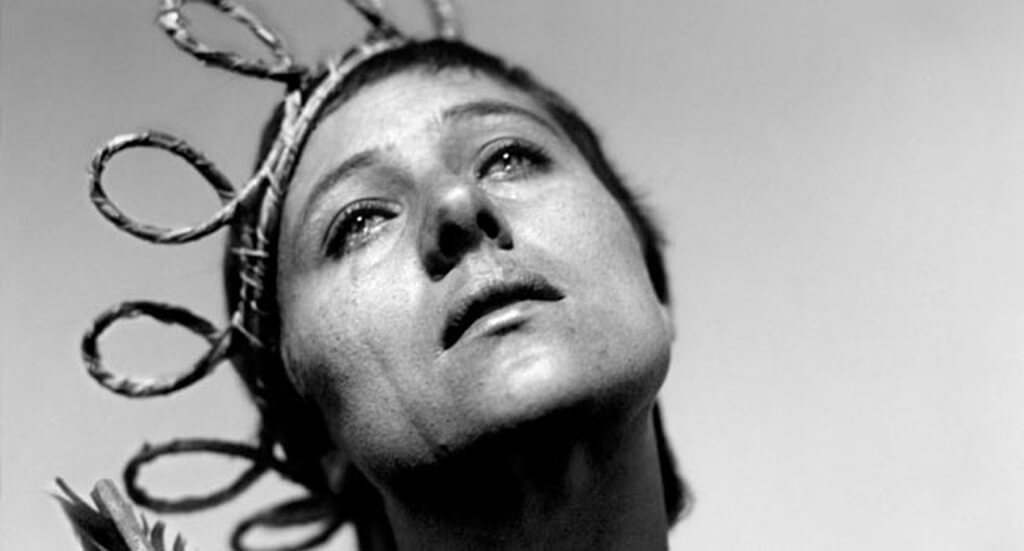
The Orlando Consort at Koerner Hall. Sunday, April 3, 2016.
The Orlando Consort brought their latest project, a live vocal accompaniment to Carl Dreyer’s 1928 silent film The Passion of Joan of Arc, to Koerner Hall on Sunday afternoon. Glowing from the light of the laptop screens they used to synch their performance with the film, they delivered a set of early renaissance a cappella music while the audience (surprisingly small — about half the hall) took in one of the great masterpieces of cinema and a world-class concert at the same time.
A multitude of scores have been produced for this film, and Dreyer was famously lukewarm about all those he heard in his lifetime. But the Orlando Consort’s is the first score to consist of music contemporary with the action of the film — it all dates from the early 15th Century — and this has produced a compelling sense of authenticity.
While it is peculiar to say this of an Orlando Consort performance, the music was not meant to be the centre of attention here. Consort member Donald Greig has written that their purpose with this work is strictly to serve the film, and that any focus on the singers themselves will inevitably be at the expense of the film. So while the music was marvelous, as you would expect, with astoundingly precise harmonies and rich timbres made immediately intimate through Koerner’s excellent acoustics, the real question is this: how did the Consort’s performance serve the film?
The answer: quite well, for the most part. The film is visually and narratively austere, and this was complemented nicely by the five naked voices. The film’s ambiguities were also well-served by the music’s emotional versatility, at once somber and joyful, comforting yet mournful.
The choral score played a number of roles, sometimes representing the speech of a character (often solo chant), sometimes capturing the film’s whispered accusatory rumours through polyphony, sometimes simply channeling the overall mood of the piece. Perhaps most provocatively, the music’s angelic ethereality seemed at times to represent the voices Joan of Arc is reported to have heard from God. The most powerful parts of the soundtrack were silences, though, as when Joan of Arc wouldn’t (or couldn’t) answer her accusers, or during her death sentence near the film’s end. The Consort did not exploit this power of silence nearly enough throughout the work, and the power of their singing was thereby weakened by over-saturation.
A working knowledge of church Latin was necessary to understand most of the Consort’s programming choices. During the bloodletting of Joan of Arc, they were singing a line from the text Ave Verum Corpus, “whose pierced side flowed with water and blood,” and when communion was offered and then denied her they sung a setting of the Agnus Dei. The program notes could have helped the average listener here (though perhaps at the expense of viewing the film), but they were very thin. A full scene breakdown is available at the Consort’s website.
When the film ended, the Consort continued singing for another minute or so, glowing in the dark once again, and this chance to focus fully on the music was a gift, though it exposed the way the music and the film had occasionally competed over the course of the screening. Film scores are funny things, sometimes purposefully bland so as not to steal attention, and the Orlando Consort’s performance overwhelmed the film at times. The use of more silence would have helped alleviate this, and would have the added benefit of preserving the Consort’s voices for a more prolonged session after the film, giving the audience a chance to focus fully on their superb singing. For all we hear about the 21st Century brain’s ability to multi-task, we still cannot fully watch and listen at the same time, it would seem.
These reservations aside, any fan of liturgical choral music was given an exquisite concert yesterday afternoon, and cinephiles were reacquainted with a classic in a new and engaging way. All were treated to a thought-provoking experiment that questioned the relationship between sound and image.
#LUDWIGVAN
Want more updates on Toronto-centric classical music news and review before anyone else finds out? Get our exclusive newsletter here and follow us on Facebook for all the latest.
- FEATURE | Beyond The Concert Hall: Toronto’s Church Music Scene - November 22, 2018
- FEATURE | Where To Buy Classical Vinyl In Toronto - December 9, 2016
- SCRUTINY | A Cult Novelist Makes Great Conversation With Former TSO Conductor Seiji Ozawa - October 31, 2016



